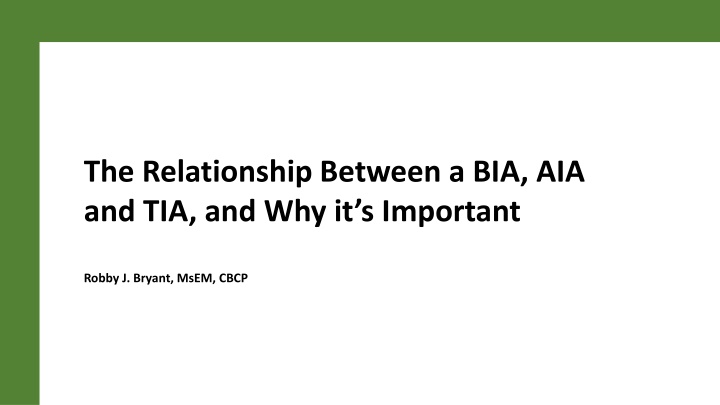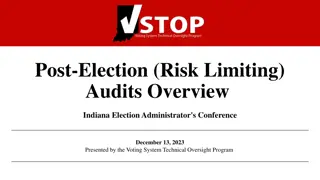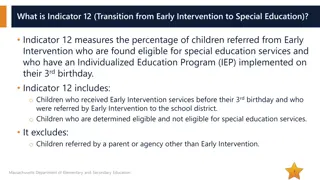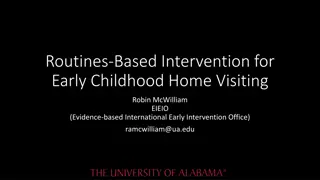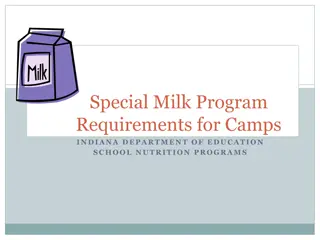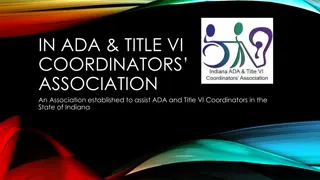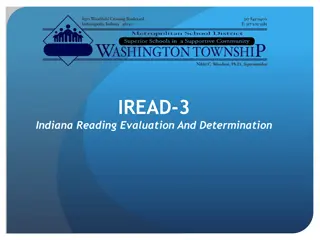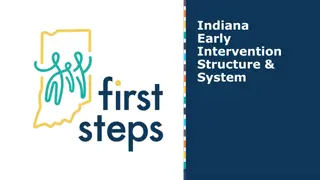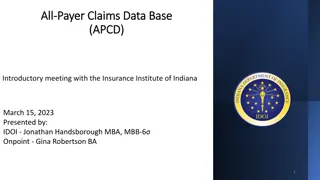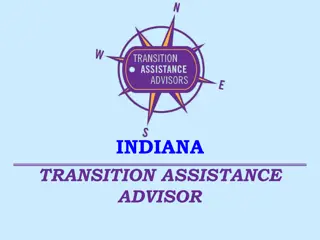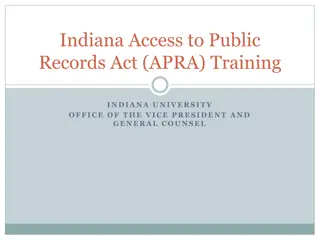Indiana Early Intervention Structure & System
"The Indiana Early Intervention Structure & System involves monitoring and improvement activities to ensure quality services. It includes provider agency monitoring, focused monitoring on SPOEs, provider agencies, and independent providers, as well as identification of noncompliance and performance concerns. Various review activities, corrective actions, and verification processes are undertaken to enhance early intervention services."
Download Presentation

Please find below an Image/Link to download the presentation.
The content on the website is provided AS IS for your information and personal use only. It may not be sold, licensed, or shared on other websites without obtaining consent from the author.If you encounter any issues during the download, it is possible that the publisher has removed the file from their server.
You are allowed to download the files provided on this website for personal or commercial use, subject to the condition that they are used lawfully. All files are the property of their respective owners.
The content on the website is provided AS IS for your information and personal use only. It may not be sold, licensed, or shared on other websites without obtaining consent from the author.
E N D
Presentation Transcript
The Relationship Between a BIA, AIA and TIA, and Why it s Important Robby J. Bryant, MsEM, CBCP
About the Speaker Robby Bryant has been involved in DR, Business Continuity and Organizational Resiliency for over 20 years with experience in insurance, manufacturing, retail and IT. He has authored Business Continuity and Disaster Recovery articles in Disaster Recovery Journal, the Journal of Business Continuity & Emergency Planning, and the Information Management Forum. Robby holds a Masters of Science degree in Emergency Management, and holds the CBCP, ISO 22301 Lead Auditor, Agile SCRUM Certified Product Owner, CHPP, ITIL v3, and NC- EMT certifications. Robby has also served as a Captain with his local volunteer fire department for over 17 years. Robby Bryant fireguync@gmail.com Cell. (336) 689-4480
Business Impact Analysis - BIA In a BIA, the organization s business processes are analyzed to know what impact is produced in the event of an incident that causes the interruption of these processes. The objective is to identify which are the most critical processes for the company. Business continuity should focus on those processes in which availability is vital, i.e., in the event of being interrupted, the impact caused to the organization may not be acceptable in a short period of time.
Business Process Analysis Business Process Entry Point Exit Point DATA DATA DATA DATA DATA DATA DATA DATA DATA DATA DATA DATA DATA DATA MATERIALS MATERIALS MATERIALS MATERIALS MATERIALS MATERIALS MATERIALS MATERIALS VALUE RISK
Business Impact Analysis BIA Questions Keep questions focused at the Business Impact/Process Level Examples: 1. What applications support this business process? 2. Are there manual workarounds for this business process if an application fails and how long can these be implemented? 3. What is the estimated maximum tolerable downtime for this business process? 4. Does this business process support employee, site or product safety? 5. What are the financial impacts if this business process should be down for 0-24hrs, 24-72hrs, 72hrs or greater? 6. What are the regulatory/legal impacts if this business process should be down for 0-24hrs, 24-72hrs, 72hrs or greater? 7. What are the reputational/stakeholder impacts if this business process should be down for 0-24hrs, 24-72hrs, 72hrs or greater? 8. What are the local/state/federal reporting requirements that may be impacted if this business process should be down for 0-24hrs, 24-72hrs, 72hrs or greater? 9. Does this business process support other critical business processes?
Application Impact Analysis - AIA In an AIA, the organization s applications are analyzed to know what impact is produced in the event of an incident that causes the interruption of these applications. The objective is to identify which are the most critical applications for the company. IT Risk/DR Operations should focus on those applications in which availability is vital, i.e., in the event of being interrupted, the impact caused to the organization may not be acceptable in a short period of time.
Application Impact Analysis Business Process DATA DATA DATA DATA DATA DATA DATA DATA DATA DATA DATA DATA DATA DATA MATERIALS MATERIALS MATERIALS MATERIALS MATERIALS MATERIALS MATERIALS MATERIALS SAP SAP SQL MD MM SAP PEAK SHIP CITRIX Oracle Completed BIA is an Input to AIA Application Level
Application Impact Analysis AIA Questions Keep questions focused at the Application Impact Level Examples: 1. Is this application Off-the-Shelf, Internally Developed or a Hybrid (purchased off-shelf but then internally developed)? 2. Who is responsible for supporting this application? 3. What business process(s) does this application support? 4. What technical workarounds are available if this application fails? 5. How long can these workarounds be implemented for (would require validation with the Business) 6. Where is this application hosted, cloud, on-premise, hybrid or shop floor? 7. What components does this application rely on and how many: databases, linux servers, windows servers, Citrix servers, storage, etc? 8. What are the Upstream and Downstream dependencies for this application? 9. Where are these dependent applications hosted? 10.What is the estimated maximum tolerable downtime for this application?
Technical Impact Analysis - TIA In a TIA, the organization s technologies are analyzed to know what impact is produced in the event of an incident that causes the interruption of these technologies. The objective is to identify which are the most critical technologies for the company. IT Risk/DR Operations/IT Infrastructure should focus on those technologies in which availability is vital, i.e., in the event of being interrupted, the impact caused to the organization may not be acceptable in a short period of time.
Technical Impact Analysis SAP SAP SQL MD MM SAP PEAK SHIP CITRIX Oracle Application Level SAN LUN 1 SAN LUN 1 SAN LUN 1 SAN LUN 1 Completed AIA is an Input to TIA SAN LUN 1 VMWare SAN LUN 2 VMWare SAN LUN 0 AWS Azure AWS Technical Level
Technical Impact Analysis TIA Questions Questions focused at the Technical Impact Level Examples: 1. How old is the technical infrastructure supporting this application and when does standard support expire? 2. Who is responsible for supporting this technology, internal team, external vendor or both? 3. Is the data storage location for this application shared by other critical applications? If so how many critical applications share the same storage drive space/storage LUN/Storage Array/AZ/Region? 4. Has a single point of failure analysis been completed for this technology? 5. What technical workarounds are available if this technology fails? 6. How long can these workarounds be implemented for (would require validation with the Application Owner) 7. Is the server infrastructure supporting this application virtualized, physical or a mix? 8. What are the upstream/downstream technical dependencies for the application supporting technology. 9. What redundancies exist for this technical infrastructure? If no redundancies exist how quickly can replacements be secured? 10.Where are the configurations for the technical infrastructure backed up/replicated to and how often?
The Big Picture Business Process DATA DATA DATA DATA DATA DATA DATA DATA DATA DATA DATA DATA DATA DATA MATERIALS MATERIALS MATERIALS MATERIALS MATERIALS MATERIALS MATERIALS MATERIALS VALUE SAP SAP SQL MD SAP MM PEAK SHIP CITRIX Oracle Application Level RISK SAN LUN 1 SAN LUN 1 SAN LUN 1 SAN LUN 1 SAN LUN 1 VMWare SAN LUN 2 VMWare SAN LUN 0 AWS Azure AWS Technical Level
The Bigger Picture Business Process DATA DATA DATA DATA DATA DATA DATA DATA DATA DATA DATA DATA DATA DATA MATERIALS MATERIALS MATERIALS MATERIALS MATERIALS MATERIALS MATERIALS MATERIALS VALUE SAP SAP SQL MD SAP MM PEAK SHIP CITRIX Oracle Application Level RISK SAN LUN 1 SAN LUN 1 SAN LUN 1 SAN LUN 1 SAN LUN 1 VMWare SAN LUN 2 VMWare SAN LUN 0 AWS Azure AWS Technical Level
Requirements Understand and Document the Business Processes and Supporting Applications Understand IT Architecture and Supporting Technologies Good Governance and Good Change Management processes Good Change Management Stewardship and a Good Change Management Database Relationship Tracking Tool (ServiceNow, Vue, etc) or a way to create/manage these relationships A REALLY Good SCRUM Master Senior Leadership Support ($$$)
